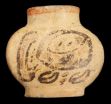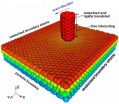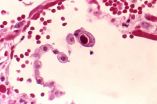EARTH: Source code: The methane race
2012-01-13
(Press-News.org) Alexandria, VA –What is the lifespan of a natural gas deposit? How quickly is our planet's permafrost melting? And does life exist on other planets? Although seemingly unrelated issues, the answers to these questions are linked. And in this month's issue of EARTH Magazine, scientists show that we may be closer to answering them than we think.
Ten years ago, John Eiler, a geochemist at Caltech, couldn't convince anyone to build him his dream machine. He wanted a mass spectrometer that could measure the mass of common gases with extreme precision and sensitivity. Using methane, this instrument could potentially unlock the answers to many unsolved questions and provide us with a whole new perspective on paleoclimate and ancient temperatures.
Eiler has already been successful in modifying a standard mass spectrometer to use isotopologues (chemically identical, but isotopically different molecules) of carbon dioxide as a time-traveling thermometer. So far, this technology has discovered the body temperature of woolly mammoths and dinosaurs, and has even pinned down highly disputed ocean temperatures hundreds of millions of years old. Now, as EARTH explores in Source Code: The Methane Race, available at http://www.earthmagazine.org/earth/article/5eb-7dc-1-a, the race is on to use methane as a proxy to identify and solve new mysteries.
Crack the methane source code and read other great stories in the January of issue of EARTH Magazine, available online now at http://www.earthmagazine.org/. Discover what gives dinoflagellates their glow; find India's missing ground; and view the latest bolide strike models in the most recent issue of EARTH.
###
Keep up to date with the latest happenings in Earth, energy and environment news with EARTH magazine online at http://www.earthmagazine.org/. Published by the American Geosciences Institute, EARTH is your source for the science behind the headlines.
The American Geosciences Institute is a nonprofit federation of 50 geoscientific and professional associations that represents more than 250,000 geologists, geophysicists and other earth scientists. Founded in 1948, AGI provides information services to geoscientists, serves as a voice of shared interests in the profession, plays a major role in strengthening geoscience education, and strives to increase public awareness of the vital role the geosciences play in society's use of resources, resiliency to natural hazards, and interaction with the environment.
END
ELSE PRESS RELEASES FROM THIS DATE:
2012-01-13
(Boston) – A review article by researchers at Boston University School of Medicine (BUSM) debunks the widely-believed concept that hypertension, or high blood pressure, is the result of excess salt causing an increased blood volume, exerting extra pressure on the arteries. Published online in the Journal of Hypertension, the study demonstrates that excess salt stimulates the sympathetic nervous system to produce adrenalin, causing artery constriction and hypertension.
The research was led by Irene Gavras, MD, and Haralambos Gavras, MD, both professors of medicine at BUSM. ...
2012-01-13
ATLANTA –January 11, 2012– Updated guidelines on nutrition and physical activity for cancer prevention from the American Cancer Society stress the importance of creating social and physical environments that support healthy behaviors. The report includes updated recommendations for individual choices regarding diet and physical activity patterns, but emphasizes that those choices occur within a community context that can either help or hinder healthy behaviors.
The updated guidelines include recommendations for community action to accompany the four major recommendations ...
2012-01-13
Troy, N.Y. – A scientist at Rensselaer Polytechnic Institute and an anthropologist from the University at Albany teamed up to use ultra-modern chemical analysis technology at Rensselaer to analyze ancient Mayan pottery for proof of tobacco use in the ancient culture. Dmitri Zagorevski, director of the Proteomics Core in the Center for Biotechnology and Interdisciplinary Studies (CBIS) at Rensselaer, and Jennifer Loughmiller-Newman, a doctoral candidate at the University at Albany, have discovered the first physical evidence of tobacco in a Mayan container. Their discovery ...
2012-01-13
Why do heavy coffee drinkers have a lower risk of developing Type 2 diabetes, a disease on the increase around the world that can lead to serious health problems? Scientists are offering a new solution to that long-standing mystery in a report in ACS' Journal of Agricultural & Food Chemistry.
Ling Zheng, Kun Huang and colleagues explain that previous studies show that coffee drinkers are at a lower risk for developing Type 2 diabetes, which accounts for 90-95 percent of diabetes cases in the world. Those studies show that people who drink four or more cups of coffee daily ...
2012-01-13
Nobel laureate poet Rabindranath Tagore once wrote, "Let your life lightly dance on the edges of time like dew on the tip of a leaf." Now, a new study is finally offering an explanation for why small dew drops do as Tagore advised and form on the tips, rather than the flat surfaces, of leaves. It appears in ACS' journal Langmuir.
In the study, Martin E. R. Shanahan observes that drops of water have a preference for exactly where they collect on leaves as their surfaces cool in the morning and afternoon. Those droplets, which condense from water vapor — moisture — in the ...
2012-01-13
Scientists are reporting development and initial laboratory tests of an imaging agent that shows promise for detecting the tell-tale signs of Alzheimer's disease (AD) in the brain — signs that now can't confirm a diagnosis until after patients have died. Their report appears in the journal ACS Medicinal Chemistry Letters.
Masahiro Ono and colleagues explain that no proven laboratory test or medical scan now exists for AD, which is claiming an increasingly heavy toll with the graying of the world's population. Patients now get a diagnosis of AD based on their medical history ...
2012-01-13
Promoting immunizations as a part of routine office-based medical practice is needed to improve adult vaccination rates, a highly effective way to curb the spread of diseases across communities, prevent needless illness and deaths, and lower health care costs, according to a new RAND Corporation study.
Increasingly, vaccinations are being offered outside of physician offices at pharmacies, workplaces and retail medical clinics. Even so, office-based medical practice continues to be central to the delivery of recommended vaccinations to adults.
"Regardless of where vaccines ...
2012-01-13
Similar to the way pavement, softened by a hot sun, will slow down a car, graphene—a one-atom-thick sheet of carbon with wondrous properties—slows down an object sliding across its surface. But stack the sheets and graphene gets more slippery, say theorists at the National Institute of Standards and Technology (NIST), who developed new software to quantify the material's friction.
"I don't think anyone expects graphene to behave like a surface of a three-dimensional material, but our simulation for the first time explains the differences at an atomic scale," says NIST ...
2012-01-13
A new clinical Standard Reference Material (SRM) from the National Institute of Standards and Technology (NIST) will help health care professionals more accurately diagnose and treat cytomegalovirus (CMV), a common pathogen that is particularly dangerous for infants and persons with weakened immune systems.
CMV is found in 50 to 80 percent of the population. It is a member of the herpes family of viruses that includes two herpes simplex viruses (the causes of cold sores and genital herpes), the varicella-zoster virus (the cause of chicken pox and shingles) and the Epstein-Barr ...
2012-01-13
With a random-looking spatter of paint specks, a pair of cameras and a whole lot of computer processing, engineer Mark Iadicola of the National Institute of Standards and Technology (NIST) has been helping the Federal Highway Administration (FHWA), in cooperation with the American Association of State Highway and Transportation Officials (AASHTO), to assure the safety of hundreds of truss bridges across the United States. Iadicola has been testing the use of a thoroughly modern version of an old technique—photographic measurement or "photogrammetry"—to watch the failure ...
LAST 30 PRESS RELEASES:
[Press-News.org] EARTH: Source code: The methane race


